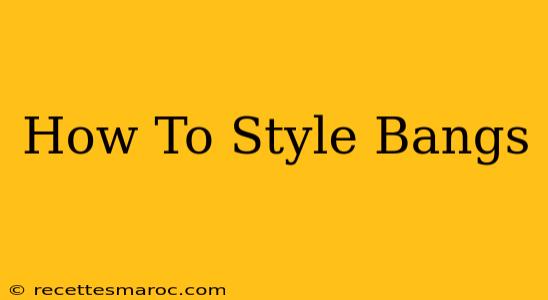Bangs, or fringe, can dramatically change your look, adding a touch of chic, playful charm, or sophisticated edge. But achieving that perfect bang look requires a bit of know-how. This guide will walk you through various styling techniques for different types of bangs, ensuring you can rock your fringe with confidence.
Understanding Your Bang Type
Before diving into styling, it's crucial to understand what type of bangs you have. This will determine the best styling approach. Common bang types include:
- Blunt Bangs: These are straight-across bangs, typically heavy and thick. They require precision cutting and styling.
- Side-Swept Bangs: These bangs are swept to the side, offering a softer, more relaxed look. They're versatile and easy to manage.
- Curtain Bangs: These bangs are parted in the middle and fall softly on either side of your face, framing it beautifully. They are very trendy right now.
- Wispy Bangs: These are lighter and more textured bangs, giving a carefree, bohemian vibe. They're less demanding to style.
- Textured Bangs: These bangs incorporate layers and texture, adding dimension and movement. Styling depends greatly on the specific texture.
Essential Tools for Styling Bangs
Having the right tools is half the battle. Here’s what you'll need:
- Hairdryer: A must-have for drying and shaping your bangs. A hairdryer with a concentrator nozzle provides focused airflow.
- Round Brush: A small round brush is perfect for adding volume and curl to bangs.
- Flat Iron: For sleek, straight bangs, a flat iron is essential. Use a heat protectant spray beforehand!
- Comb: A fine-toothed comb helps with precise parting and smoothing.
- Hair Clips: For sectioning your hair and keeping it out of the way.
- Hairspray: Provides hold and keeps your bangs in place throughout the day.
- Texturizing Spray/Serum: Depending on your bang type and desired look, a texturizing product can add volume or definition.
Styling Techniques for Different Bang Types
Styling Blunt Bangs
1. Blow-dry: Use a round brush to lift the bangs at the roots while blow-drying. Direct the airflow downwards to create a smooth, sleek finish. 2. Flat Iron (Optional): For an extra-sleek look, use a flat iron to straighten any remaining waves or kinks. 3. Hairspray: Finish with a light mist of hairspray to keep your bangs in place.
Styling Side-Swept Bangs
1. Blow-dry: Dry your bangs slightly, then use a round brush to gently sweep them to the side, following the natural direction of your hair growth. 2. Hairspray: Set your side-swept bangs with a light-hold hairspray. 3. Optional styling products: Consider adding a styling cream or pomade for extra definition and hold.
Styling Curtain Bangs
1. Air Dry or Blow-dry: Curtain bangs often look great air-dried. If you blow-dry, use your fingers to gently guide them to fall naturally on either side of your face. 2. Texturizing Spray (Optional): A light texturizing spray adds subtle volume and movement.
Styling Wispy Bangs
1. Air Dry: Wispy bangs are generally best styled by air drying. 2. Texturizing Spray: A texturizing spray or sea salt spray enhances their natural texture and adds effortless volume.
Troubleshooting Common Bang Problems
- Bangs are too heavy: Try layering them or using a texturizing product to lighten them up.
- Bangs are too short: Embrace the style! Short bangs can be chic and edgy. Use a setting spray to prevent stray strands.
- Bangs look greasy: Dry shampoo is your best friend.
Maintaining Your Bangs
Regular trims are crucial for maintaining the shape and style of your bangs. Aim for a trim every 3-4 weeks to keep them looking their best.
By following these tips and techniques, you’ll be well on your way to mastering the art of styling your bangs and confidently showcasing your unique look. Remember, practice makes perfect! Experiment with different products and techniques to find what works best for your hair type and desired style.

